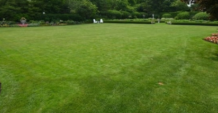By: Scott Eckert, County Extension Agent, Horticulture
Fall webworm produces two generations per year. Adult moths emerge from overwintering pupa in the spring. After mating, females lay masses of eggs (400 to 500) on the undersides of leaves. The larvae feed in colonies in web enclosed foliage. They begin by constructing small webs near the ends of branches and gradually increase the size of the web as the need for food increases. Mature caterpillars are yellowish with black and brown markings, and have many tufts of long hair. Feeding continues for four to six weeks. Mature larvae crawl down the tree and pupate in the litter on the ground. Pupation normally occurs in June with the adults of the second generation appearing in late June to early July. These adults mate and the female lays eggs. Second generation larvae are usually present from late July through late September. As larvae mature, they crawl down the tree and spend the winter as pupa in the leaf litter under the tree.
The first generation is often small and usually goes unnoticed. The second generation is much larger and more noticeable. This insect is present more often on trees that are not surrounded by other trees. Infestations are more common in eastern and southern Kansas.
High populations of fall webworm can completely defoliate host plants but do not kill them. However, on pecan trees, nut production and quality can be reduced if webworms are not controlled. On ornamental plants, control is optional.
So what can you do?
Pruning and destroying the infested portions of branches is a common control practice while webs are still small. Also, a stick or pole with a nail inserted crosswise can be used to snag individual webs. Twisting the pole after insertion will cause the web to wrap around the pole where it can be removed and destroyed.
Chemicals need to be applied while webs are small and before much foliage has been destroyed. A high pressure sprayer is needed to penetrate the webs of more mature colonies.
Numerous products can be used for control including spinosad (Conserve; Fertilome Borer, Bagworm, Leafminer and Tent Caterpillar Spray; Captain Jack´s Dead Bug Brew), cyfluthrin (Tempo, Bayer Vegetable & Garden Insect Spray) and permethrin (numerous trade names).




